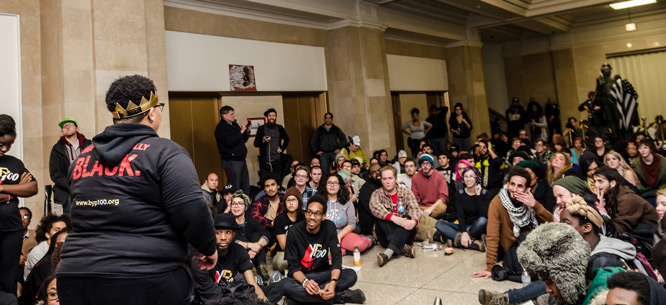Teaching the #FergusonSyllabus
Teaching the #FergusonSyllabus
The #FergusonSyllabus has organized a disparate population of scholars and students into a virtual movement using Ferguson to frame how struggle has shaped American history.

When the unrest in Ferguson unfolded in August, I was among the millions transfixed by the images broadcast live from the heartland. Ferguson’s first act featured a grief-stricken community, the choreography of “hands up, don’t shoot,” and police officers costumed like soldiers—all performed on a tear-gassed stage. Yet the scenes we didn’t see captured my attention the most. I pictured the empty desks and chairs, the rows of vacant lockers, and the deserted playgrounds during an unexpectedly prolonged summer for children in Ferguson. I wanted other educators to think about how painful the introduction to a new school year would be for this town. I hoped to challenge my colleagues on campuses across the country to devote the first day of classes to a conversation about Ferguson.
What emerged was a small call for community across the sometimes impersonal and expansive digital world. I asked professors who used Twitter to talk about Ferguson and to use #FergusonSyllabus to recommend texts, collaborate on conversation starters, and inspire dialogue about some aspect of the Ferguson crisis. Slowly high school teachers, early education specialists, guidance counselors, and middle-school instructors wanted ideas too.
The academy has never owned movements, and youth outside of colleges longed for intelligent questions, honest reflection, and inspiration moving forward. The #FergusonSyllabus organized a disparate population of scholars and students into a virtual movement that used Ferguson to frame how struggle has shaped American history, infused great works of art and literature, and given voice to those most hurt by the failures of leadership, capitalism, and democracy.
When the news that a St. Louis County grand jury decided not to bring Officer Darren Wilson to trial for the killing of Michael Brown, the movement in Ferguson and across the county was reignited. On the ground, activists declaring “Shut it down” and exclaiming “Black lives matter” blocked highways, occupied city halls, and resisted the notion that the grand jury would have the final word on what Ferguson means. Online, the #FergusonSyllabus is also in its second act. Within a few moments, educators began again, suggesting ways to make the most of a pre-holiday class meeting after the announcement. A middle school teacher in Madison, Wisconsin had students review the grand jury evidence. Meanwhile, I had my students in Washington, D.C. connect the Ferguson decision to Rosa Parks’s activism in seeking trials for black women raped by white men in the South. Volunteers in Ferguson read books from #FergusonSyllabus to children—unexpectedly out of school again—at the local public library.
Schools in Ferguson and across the country were closed over the past few days—this time to celebrate the start of the holiday season. Yet the emptiness remains. For the first time, Michael Brown’s family had an extra dining chair at their table this year. And, for many students, this is the first time they are witnessing the dramatization of a protest novel being written everyday as the Ferguson movement seeks law enforcement accountability, the decriminalization of blackness and of poverty, and schools that move children toward liberation rather than confinement. Whether you find yourself teaching in a schoolhouse, in your living room with your children, at a community meeting filled with movement members, in a church basement with others who seek racial reconciliation, or in a detention center common room, the resources below provide a snapshot of what is being taught, what is being felt, and what is being created each day.
Recommendations from #FergusonSyllabus
Engaging Ferguson in Ohio Social Studies Classrooms Website
Wabash Center for Teaching and Learning in Theology and Religion: Resources on Social Justice Education
Liz Dawes Duraisingh, Responding to Ferguson (Out of Eden, November 26, 2014)
Danielle L. McGuire, At the Dark End of the Street: Black Women, Rape, and Resistance: A New History of the Civil Rights Movement from Rosa Parks to the Rise of Black Power
Jenée Desmond-Harris, Do’s and Don’ts for Teaching about Ferguson, (The Root.com, September 2, 2014)
Colin Gordon, The Making of Ferguson (Dissent, August 16, 2014)
Rebecca Klein, Here’s What These High School Students Had to Say About Events in Ferguson (Huffington Post, November 26, 2014)
Mari Evans, “If There Be Sorrow”
Langston Hughes, “I, Too, Sing America”
David Perry, Chronicle of Higher Education: #FergusonSyllabus (November 25, 2014)
Katherine Schulten, Tom Marshall, and Michael Gonchar, The Death of Michael Brown: Teaching About Ferguson (New York Times Learning Blog, September 3, 2014)
Ralph Ginzburg, 100 Years of Lynchings
Anthony Grooms, Bombingham
Gwendolyn Brooks, “Riot”
Claude McKay, “If We Must Die”
For more resources, follow #FergusonSyllabus on Twitter.
Marcia Chatelain, a proud graduate of the University of Missouri-Columbia, is assistant professor of history at Georgetown University. Her book South Side Girls: Growing Up in the Great Migration will appear with Duke University Press in 2015.






